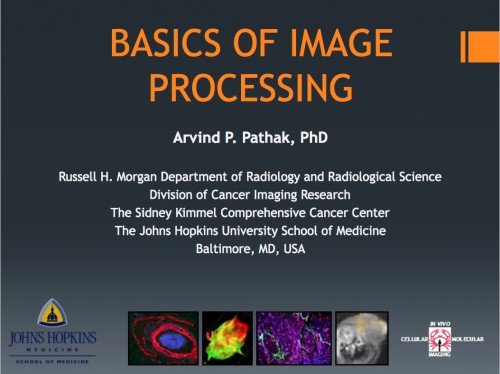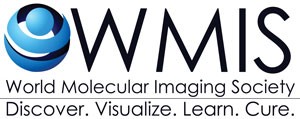D. Post Processing and Cross Validation
2. Basics of Image Processing: Part 3
Moderated by Arvind Pathak

Please click the slide image to open and view the presentation. Please note- the slides in the presentation can be advanced using the navigation controls on the presentation frame.
Basics of Image Processing
Arvind Pathak
Russell H. Morgan Radiology and Radiological Science, Division of Cancer Imaging Research, The Sidney Kimmel Comprehensive Cancer Center, The Johns Hopkins University School of Medicine, Baltimore, Maryland, USA
Learning Objectives:
- Familiarize the audience with basic molecular imaging methods.
- Learn basic image processing principles relevant to molecular imaging.
- Learn about new imaging methods.
- Learn about how to harness these advances to better understand disease models.
This lecture will briefly cover the following topics:
- Introduction to Molecular Imaging
- Digital image fundamentals
- Intensity transformations
- Filtering in the frequency domain
- Color image processing
- Spectral deconvolution
- Multiscale/multimodal imaging
- Morphological image processing
- Image-based phenotyping
Relevant Publications:
- Kim E, Stamatelos S, Cebulla J, Bhujwalla ZM, Popel AS, Pathak AP. Multiscale imaging and computational modeling of blood flow in the tumor vasculature. AnnBiomed Eng. 2012 Nov;40(11):2425-41. doi: 10.1007/s10439-012-0585-5. Epub 2012May 8. Review. PubMed PMID: 22565817; PubMed Central PMCID: PMC3809908.
- Penet MF, Mikhaylova M, Li C, Krishnamachary B, Glunde K, Pathak AP, BhujwallaZM. Applications of molecular MRI and optical imaging in cancer. Future Med Chem.2010 Jun;2(6):975-88. Review. PubMed PMID: 20634999; PubMed Central PMCID:PMC2902367.
- Pathak AP, Penet MF, Bhujwalla ZM. MR molecular imaging of tumor vasculatureand vascular targets. Adv Genet. 2010;69:1-30. doi:10.1016/S0065-2660(10)69010Review. PubMed PMID: 20807600.4:
- Glunde K, Jacobs MA, Pathak AP, Artemov D, Bhujwalla ZM. Molecular andfunctional imaging of breast cancer. NMR Biomed. 2009 Jan;22(1):92-103. doi:10.1002/nbm.1269. Review. PubMed PMID: 18792419.
- Pathak AP. Magnetic resonance susceptibility based perfusion imaging of tumorsusing iron oxide nanoparticles. Wiley Interdiscip Rev Nanomed Nanobiotechnol.2009 Jan-Feb;1(1):84-97. doi: 10.1002/wnan.17. Review. PubMed PMID: 20049781.
- Winnard PT Jr, Pathak AP, Dhara S, Cho SY, Raman V, Pomper MG. Molecularimaging of metastatic potential. J Nucl Med. 2008 Jun;49 Suppl 2:96S-112S. doi:10.2967/jnumed.107.045948. Review. PubMed PMID: 18523068.
- Penet MF, Glunde K, Jacobs MA, Pathak AP, Bhujwalla ZM. Molecular andfunctional MRI of the tumor microenvironment. J Nucl Med. 2008 May;49(5):687-90. doi: 10.2967/jnumed.107.043349. Epub 2008 Apr 15. Review. PubMed PMID: 18413382; PubMed Central PMCID: PMC3075060.
- Pathak AP, Hochfeld WE, Goodman SL, Pepper MS. Circulating and imaging markersfor angiogenesis. Angiogenesis. 2008;11(4):321-35. doi:10.1007/s10456-008-9119-z. Epub 2008 Oct 17. Review. PubMed PMID: 18925424.
- Glunde K, Pathak AP, Bhujwalla ZM. Molecular-functional imaging of cancer: to image and imagine. Trends Mol Med. 2007 Jul;13(7):287-97. Epub 2007 Jun 4.Review. PubMed PMID: 17544849.
- Raman V, Pathak AP, Glunde K, Artemov D, Bhujwalla ZM. Magnetic resonanceimaging and spectroscopy of transgenic models of cancer. NMR Biomed. 2007May;20(3):186-99. Review. PubMed PMID: 17451171.
- Pathak AP. Magnetic resonance imaging of tumor physiology. Methods Mol Med.2006;124:279-97. Review. PubMed PMID: 16506426.12: Pathak AP, Bhujwalla ZM, Pepper MS. Visualizing function in thetumor-associated lymphatic system. Lymphat Res Biol. 2004;2(4):165-72. Review.PubMed PMID: 15650386.
